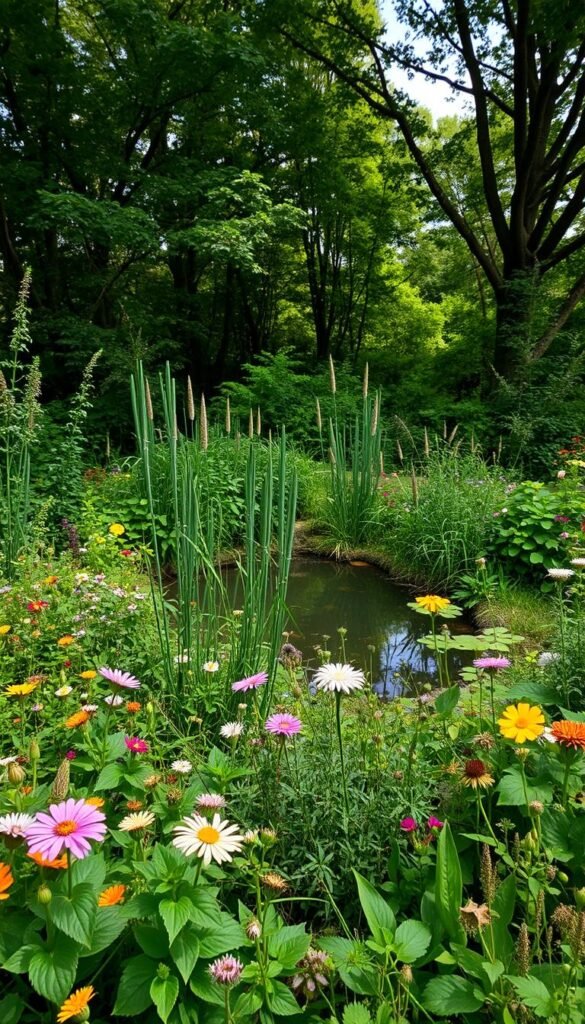Traditional lawns might look tidy, but they’re water-hungry and offer little value to local ecosystems. Imagine replacing that thirsty grass with vibrant native flowers, edible shrubs, and habitats buzzing with life. This shift isn’t just about looks—it’s about building a space where nature thrives with you, not against you.
Your outdoor area can become a sanctuary for pollinators, birds, and beneficial insects. Start small: even a 10-square-foot patch of clover or wildflowers boosts local biodiversity more than a manicured lawn ever could. By prioritizing native plants and organic methods, you’ll spend less time battling pests and more time enjoying your lively, self-sustaining oasis.
Modern designs blend beauty with purpose. Think fruit trees that feed your family and wildlife, or rain gardens that filter stormwater naturally. These permaculture principles help create landscapes that work smarter, not harder. Over time, your garden will need less watering, fewer chemicals, and minimal upkeep.
Remember: chewed leaves and uneven growth aren’t flaws—they’re signs of a healthy habitat. Your choices today shape tomorrow’s environment, one bloom and butterfly at a time.
Overview: Embracing Eco Gardening for a Sustainable Future
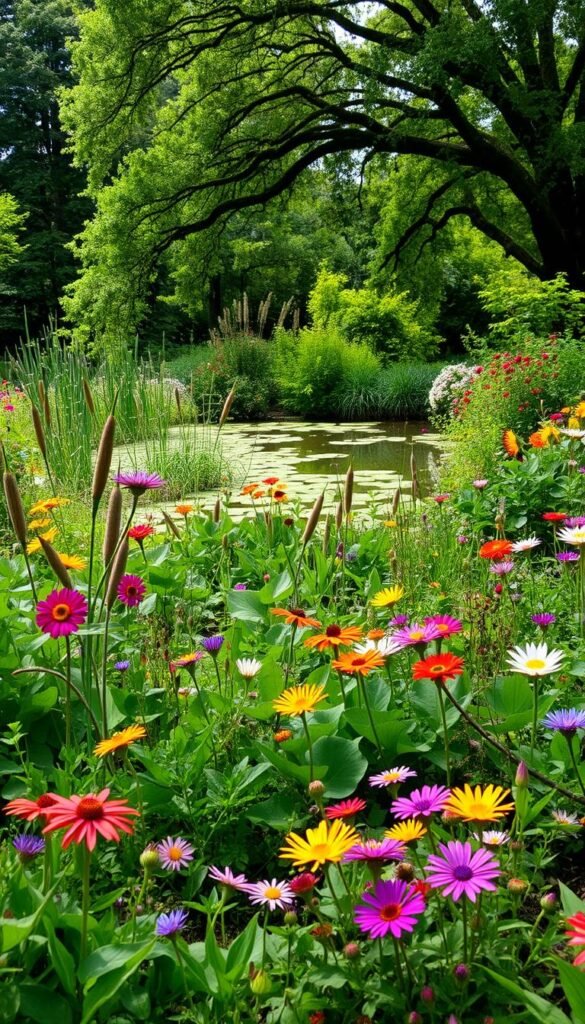
A vibrant garden does more than please the eye—it supports the planet. By working with your local environment instead of against it, you create spaces where life flourishes naturally. This approach nurtures wildlife while reducing your environmental footprint.
Understanding the Importance of Biodiversity
Diverse plantings attract birds, bees, and butterflies—key players in any healthy ecosystem. When you mix native flowers, shrubs, and trees, you build habitats that resist pests without chemicals. Studies show gardens with varied species recover faster from droughts and extreme weather.
Your choices ripple outward. A single milkweed patch can feed monarch caterpillars, while berry bushes shelter songbirds. These connections create benefits far beyond your property line.
What Eco-Friendly Gardening Means for You
Adopting eco-friendly gardening practices saves time and money. Native plants need less water once established, cutting utility bills. Healthy soil retains moisture better, reducing irrigation needs by up to 50%.
You’ll also boost your home’s curb appeal. Landscapes designed for sustainability often increase property values more than traditional lawns. Best of all? You’re creating a living space that evolves with the seasons, offering new discoveries every week.
Discovering Your Local Ecosystem and Native Plants
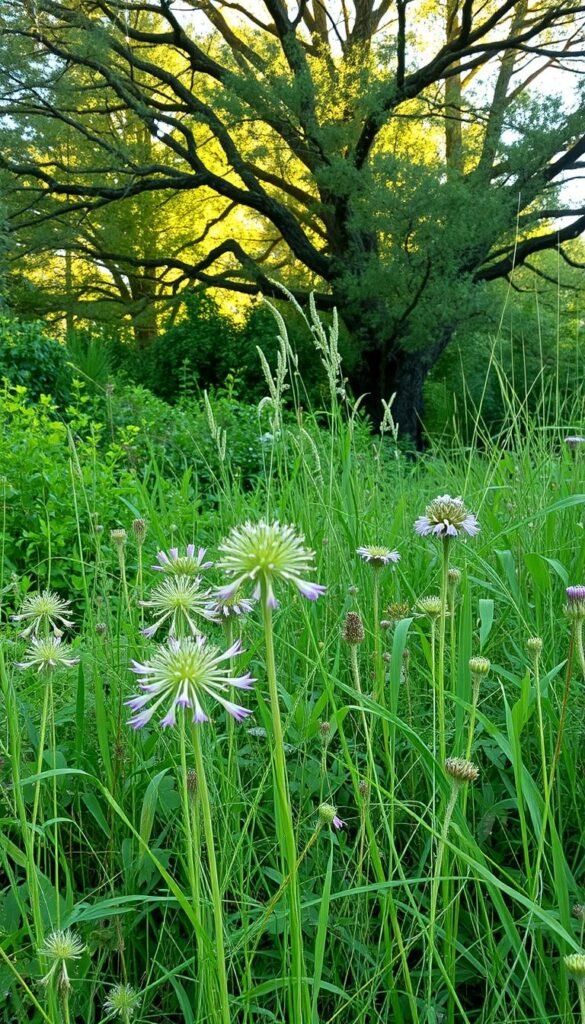
Local ecosystems offer a blueprint for a low-maintenance, wildlife-friendly garden. Start by getting to know your yard’s unique personality—its sunlight patterns, soil texture, and moisture levels shape what thrives there. Soil tests reveal pH and nutrient profiles, while observing which weeds grow naturally hints at your ground’s hidden strengths.
Identifying Climate and Soil Conditions
Your region’s average rainfall and temperature extremes determine which species survive without constant care. Clay soils hold water longer than sandy ones, affecting plant choices. Match these conditions to natives like purple coneflower (drought-tolerant) or swamp milkweed (moisture-loving) for effortless growth.
Selecting Plants that Support Local Wildlife
Choose native plants that feed caterpillars, birds, and pollinators through their life cycles. Oak trees support over 500 insect species, while goldenrod fuels migrating butterflies. Group plants with similar soil and light needs to create mini-ecosystems that sustain themselves.
Tools like the National Wildlife Federation’s Plant Finder help you pick regional stars. Avoid generic wildflower mixes—many contain non-natives. Instead, build your chemical-free haven using scientific names to ensure true locals. As one ecologist notes: “A garden planted with intention becomes nature’s grocery store.”
Creating an Eco Garden: Embracing Biodiversity and Low Impact Practices
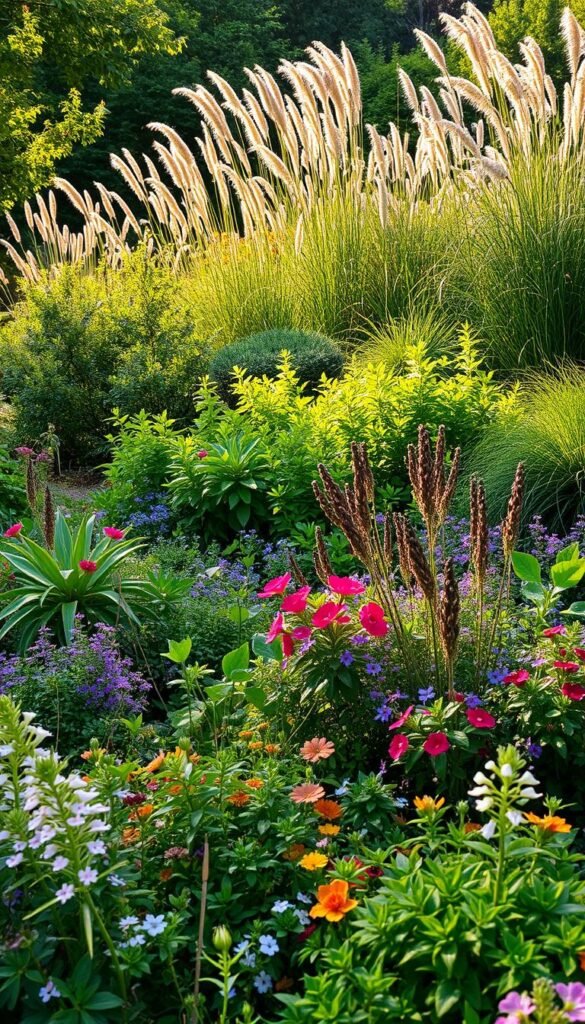
Your yard becomes a wildlife haven when you blend smart design with nature’s rhythms. Focus on plants that thrive in your area while supporting local food chains. This approach builds self-sustaining spaces where every element works together.
Mixing Locals and Climate-Adapted Varieties
Start with region-specific stars like butterfly weed for monarchs or mountain mint for bees. These native plants need less water and resist pests naturally. Pair them with adaptive species like sedum or ornamental grasses for drought resilience.
| Strategy | Benefit | Example Plants |
|---|---|---|
| Clustered Planting | Boosts visual impact | Asclepias tuberosa |
| Seasonal Blooming | Year-round food sources | Pycnanthemum muticum |
| Layered Design | Creates microhabitats | Itea virginica |
Crafting Your Wildlife Sanctuary
Follow these steps to build a balanced landscape:
- Map sunlight and soil zones in your yard
- Choose 5-7 key native plants from local nurseries
- Group matching species in 3+ areas for cohesion
Incorporate textures through grasses like little bluestem or succulents like hens-and-chicks. As noted in this native plant guide, layered designs shelter more species than single-level beds. Remember: “Diversity above ground means healthier soil below.”
Designing Wildlife-Friendly Features for Your Garden
Transform your outdoor space into a bustling hub for creatures big and small with strategic wildlife features. Simple additions create safe spaces for animals while adding character to your landscape.
Shelter Solutions That Work Overtime
Stack fallen branches or logs in shaded corners to make instant homes for beetles and hedgehogs. These natural features require zero maintenance and blend seamlessly into your garden’s aesthetic. For flying insects, hang mason bee nests or drill holes in untreated wood blocks—perfect nesting spots that boost beneficial insect populations.
Bat boxes mounted on tall poles attract nocturnal pest controllers. Position them facing south for optimal warmth. Remember: dense shrubbery near these shelters provides quick escape routes from predators.
Water Wonders That Double as Life Support
All creatures need water sources. A repurposed basin filled with stones becomes a butterfly drinking station—change the water weekly to prevent mosquitoes. Add a solar-powered fountain to moving water features; their gentle splash lures birds like robins and warblers.
Shallow dishes with pebbles help bees hydrate safely. For larger projects, bury a half-barrel liner and add aquatic plants to create mini wetlands. These setups support pollinators while serving as stunning focal points.
Pair these elements with flowering plants from your pollinator haven to create year-round support systems. As ecologist Dr. Emma Green notes: “A garden becomes truly alive when it meets every basic need on the food chain.”
Water Management and Soil Health for a Thriving Landscape
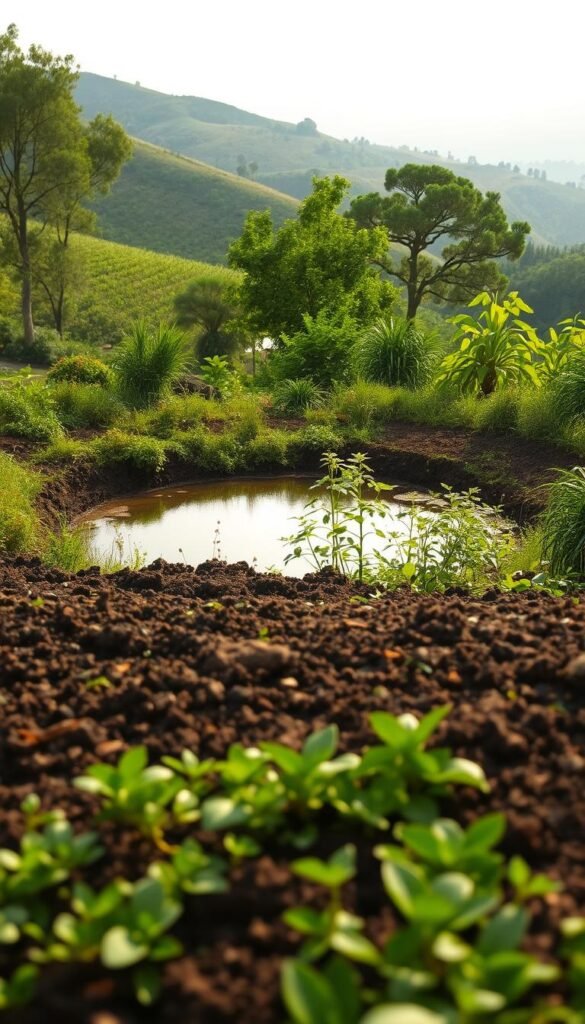
Smart water use and rich soil form the backbone of any resilient landscape. By pairing conservation strategies with earth-friendly practices, you create spaces where plants thrive while protecting local waterways.
Effective Irrigation and Rainwater Harvesting Techniques
Capture free resources with rain barrels or underground cisterns—these systems store thousands of gallons annually for dry spells. Pair them with drip irrigation lines that target root zones, cutting water waste by up to 60% compared to sprinklers.
Smart controllers adjust watering based on weather forecasts, while morning schedules reduce evaporation. For arid regions, drought-tolerant succulents and native grasses need minimal hydration once established.
Natural Composting and Mulching Practices
Turn kitchen scraps into black gold using a three-bin compost system. Layered greens (vegetable peels) and browns (fallen leaves) create nutrient-rich humus that boosts soil health naturally. Spread finished compost in spring to supercharge plant growth.
Blanket beds with organic mulch like wood chips or straw. These materials lock in moisture, prevent runoff, and suppress weeds as they break down. Renew layers annually to maintain 2-3 inch coverage—your landscape will thank you with lush growth.
Choosing Eco-Friendly Hardscaping and Sustainable Materials
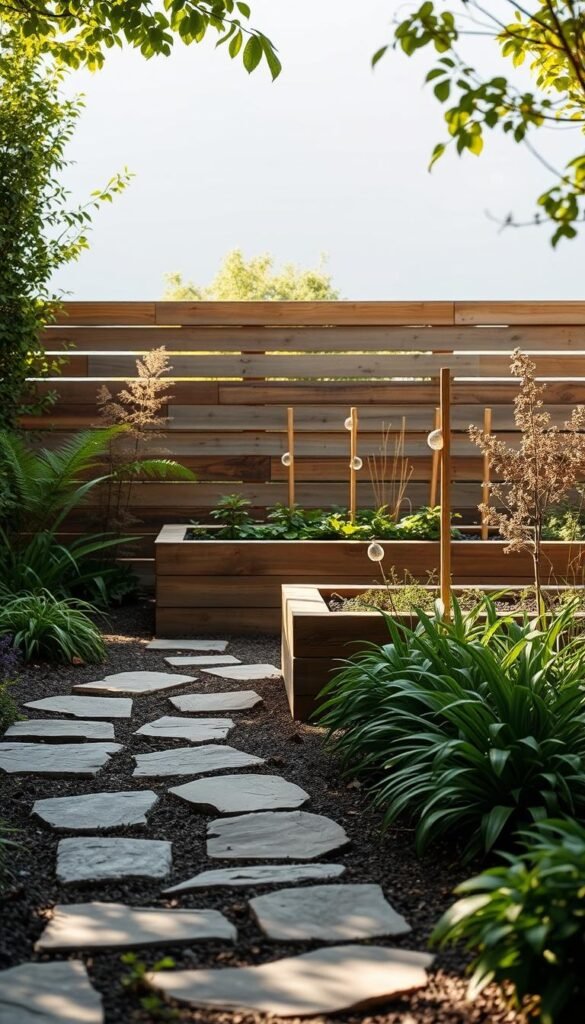
Your garden’s pathways and structures can reflect both style and sustainability. By selecting materials that align with nature’s rhythms, you create spaces that serve both people and the planet. Let’s explore how thoughtful choices reduce your impact while enhancing your landscape’s charm.
Benefits of Using Reclaimed and Locally Sourced Resources
Reclaimed wood and recycled concrete give old materials new life. These options skip energy-intensive manufacturing processes, cutting carbon emissions by up to 40% compared to new products. Plus, locally quarried stone supports nearby businesses while blending seamlessly with regional geology.
| Material Type | Environmental Benefit | Best Use |
|---|---|---|
| Reclaimed Wood | Reduces deforestation | Decking, raised beds |
| Recycled Concrete | Diverts landfill waste | Pathways, retaining walls |
| Locally Quarried Stone | Minimizes transport emissions | Edging, water features |
Permeable pavers let rainwater seep into the ground, reducing runoff that overwhelms storm drains. Pair these with hand-laid designs to protect existing trees and root systems. As landscape architect Mia Torres notes: “True beauty in design comes from honoring what’s already there.”
For budget-friendly container gardening projects, repurpose old bricks or broken pottery as drainage layers. Simple choices create cohesive outdoor spaces where every element tells an eco-conscious story.
Maintenance Strategies for a Vibrant, Low Impact Garden
Your garden thrives when care aligns with nature’s balance. Focus on maintenance practices that protect soil health while supporting pollinators and birds. These methods reduce reliance on harsh chemicals while keeping your space lively year-round.
Organic Pest Control and Integrated Management
Integrated Pest Management (IPM) starts with observation. Check plants weekly for early signs of pests, then invite allies like ladybugs or lacewings to handle infestations naturally. When intervention’s needed, reach for garlic spray or neem oil—these disrupt pests without harming bees.
| Method | Purpose | Application |
|---|---|---|
| Beneficial Insects | Controls aphids/mites | Release in early morning |
| Soap Sprays | Deters soft-bodied pests | Apply weekly to undersides |
| Companion Planting | Repels beetles/flies | Interplant marigolds |
Avoid synthetic pesticides that linger in soil and waterways. Instead, build resilience through diverse plantings. As one entomologist notes: “Healthy gardens have nibbled leaves—it means life is happening.”
Adjusting Practices with Seasonal Changes
Shift your maintenance rhythm with the weather. Water deeply but less often in fall to prepare plants for dormancy. Come spring, top-dress beds with compost instead of synthetic fertilizers.
Winter demands different control tactics. Prune diseased branches after leaf drop to prevent fungal spread. Layer mulch around perennials once the ground freezes—this protects roots without trapping moisture.
For year-round success, adopt strategies from this eco-friendly yard guide. Remember: a few aphids today could feed hungry chickadees tomorrow. Your mindful care creates ripples across the local food web.
Wrapping Up Your Journey to a Sustainable
Transforming your yard into a living ecosystem doesn’t require grand gestures—just thoughtful choices. Each native plant you grow and every water conservation step you take builds resilience in your local environment. Small changes, like adding pollinator-friendly blooms or repurposing rainwater, create ripple effects that extend far beyond your property.
Your sustainable choices merge beauty with purpose. For inspiration on blending functionality with visual appeal, explore our guide to gardening aesthetic techniques. These ideas prove eco-conscious designs can dazzle the eye while supporting wildlife.
Remember: your garden is a work in progress. Seasons change, species adapt, and new opportunities emerge. Celebrate the buzzing bees, fluttering butterflies, and thriving soil as signs of success. Every step forward—no matter how modest—contributes to a healthier planet.
Keep learning, experimenting, and growing. With patience and care, your outdoor space becomes a testament to what’s possible when we garden with nature. After all, the most vibrant landscapes aren’t just seen—they’re felt, heard, and alive.

